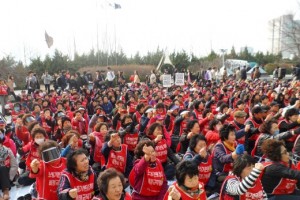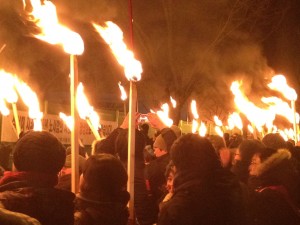The Crisis of the United Progressive Party and the Path ahead for Working-class Political Power
Posted in articles on June 20th, 2012 by pssp – Be the first to commentWhat is the United Progressive Party?
The United Progressive Party (UPP) is the most recent incarnation of a party formed original to represent the interests of the Korean working class.
From the time it was founded in 1995, the Korean Confederation of Trade Unions (KCTU) has seen ‘building workers’ political power’ as an important strategy. In line with this strategy, KCTU made an organizational decision to build a workers’ progressive party. In 2001 the Democratic Labor Party (KDLP) was founded with KCTU’s president as the party’s leader. KCTU adopted ‘building political power through the KDLP’ as its official policy.
In the 2007 presidential elections, however, the KDLP candidate received many less votes than had been expected. This led to tensions within the party as the minority left wing of the party criticizing the dominant nationalist tendency (known as National Liberation or ‘NL’) for being undemocratic and too close to North Korea. This conflict led to a split in the party with the left-wing faction leaving to form the New Progressive Party.
The split within the KDLP also led to increased sectarian conflict within KCTU. Ahead of general elections scheduled for April 2012, KCTU tried to over come these problems and bring the two parties back together throughout last year. Members of the two parties along with several progressive and people’s organizations formed the ”Committee for Grand Unity of the Left” through which they discussed the formation of a new party. The dominant part of the NL tendency (known in Korean as danggwonpa) within the KDLP, however, moved in a different direction, trying to join forces with the Participation Party, a party that had been widely criticized as supporting the interests of neoliberal capitalism. As a result of this drive by the danggwonpa, the attempts to bring the KDLP and the New Progressive Party back together failed. Instead the KDLP, the Participation Party and a small group of the New Progressive Party led by a few well-known individuals came together to form the United Progressive Party (UPP).
Evaluation of the UPP
Several forces within the Korean progressive movement opposed joining forces with the Participation Party. They have maintained that given the involvement of neoliberal Participation Party, the UPP cannot be seen as a truly progressive party. In particular, they pointed to the fact that the Participation Party was formed by members of the previous Noh Mu hyun government, which was responsible for severe labor repression, the retrogressive revision of the law on precarious workers and pursuit of the U.S.-Korea FTA.
Nonetheless, the dominant NL group within KCTU attempted to apply its previous policy of full electoral support for the KDLP to the UUP. In response, left-wing forces created the “KCTU Union Members’ Front to Oppose the Policy of Exclusive Support for the UPP and realize true Working-class Politics.” This group called on the KCTU leadership to hold an emergency delegates assembly to discussion the issue. In the end, the KCTU leadership was unable to adopt a policy of exclusive support for the UPP. It did however, force through a policy by which union members were required to vote for the UPP in the election of proportional national assembly representatives in the general election held on April 11.
Meanwhile, the UPP forced an electoral alliance with the Democratic United Party (the centrist opposition party, hereafter ‘DUP’). Through this strategy it won 7 seats in electoral districts and 6 proportional representative seats in the general elections.
Proportional Representative Election Corruption and the Deteriorating Image of the Left
Directly after the general elections, questions about the legitimacy of the UPP elections to select proportional representative candidates surfaced. An internal investigation was carried out, the report of which was released on May 2. The investigation found that grave irregularities and corruption had occurred during the internal elections leading the construction of the list of proportional representative candidates that favored the dangwonpa.
The results of the investigation were immediately picked up and played over and over again in the mainstream leading to widespread criticisms of the UPP and progressives in general among the Korean public. The criticisms of the UPP danggwonpa were particularly strong. Nonetheless, the danggwonpa rejected the findings of the report and expressed its opposition by disrupting a party Central Committee meeting on May 12, chanting and eventually resorting to physical violence.
These incidents were reported by the mainstream media leading to growing criticism of the UPP and the left in general as undemocratic. In other words, the conflict within the UPP has led to severe deterioration of the image of the entire labor and progressive movement. Even worse, the Prosecutors’ Office used the election corruption issue an excuse to raid the UPP’s office and confiscate the party server, an incident which has no precedent in the history of the Korean movement. The UPP crisis has given the government yet another tool through which to repress the left.
Never-ending Turmoil
The UPP tried to overcome the situation by creating an ‘Emergency Committee for Party Renewal’, which adopted the position that all elected proportional representatives should step down. The danggwonpa, however, refused to accept this decision and instead formed its own ‘Danggwonpa Emergency Committee’ to challenge the Renewal Emergency Committee. The danggwwonpa insists that if a more complete investigation of the proportional representative election finds real corruption they will agree to the resignations. In fact, however, it has come to light that the danggwonpa is planning to regain control of the party leadership in the upcoming party elections at the end of June.
Problems in KCTU’s Position
Despite criticism coming both from within KCTU’s membership and from other progressive forces, the KCTU leadership adopted the policy that all members should vote for the UPP in the proportional representative elections and carried out a campaign to win support for the UPP. The KCTU leadership believed that if that opposition forces (the UPP and the DUP) could gain a parliamentary majority the left could win changes favorable to workers through a legislative strategy focused on “the passage of 10 bills in 100 days.” The opposition, however, failed to win a majority. In shock and without a clear idea of how to respond, the KCTU leadership revised its plan and has instead called for a general strike later in the year to demand abolition of mass dismissals and precarious work and the progressive revision of labor law.
The crisis surrounding the UPP – the party the KCTU leadership has supported – has creating serious confusion within KCTU. After much debate the KCTU’s Central Executive Committee issued a statement on May 17 expressing, “deep concern that the UPP has currently strayed from the path of a true progressive party based in the working class and the principles of democracy.” The statement also announced that KCTU had “conditionally withdrawn support for the UPP until the party regains its working-class basis and puts a plan for renewal into practice,” and that KCTU would “establish an internal mechanism for pursuing a second attempt at ‘building workers’ political power’.”
While these measures are a step in the right direction, they do not address the deeper problems of the UPP. In particular, KCTU has put forth no critique of the inclusion of the neoliberal Participation Party in the UPP, nor has it carried out an internal evaluation of its previous policy of exclusive support for the UPP in the proportional representative election. If KCTU does not deal with these more fundamental problems, the second attempt at ‘building workers’ political power’ will most likely lead to failure.
Prospects
It will be difficult to solve the problems within the UPP in the near future. More important than a resolution to the conflict between the danggwonpa and the rest of the party, however, is the question of what direction the UPP – or any party that is supposed to represent the interests of the working class – will take. While the original KDLP was committed to ‘socialist principles and goals’ its platform was later revised to define the party’s character instead as ‘progressive democratic’. Without a clear statement of the KDLP’s basis in and commitment to the working class the party increasingly moved in a more conservative direction, eventually leading the merger with the Participation Party. Without clear criticism of these errors, it is likely that the current “Renewal Emergency Committee” will only deal with cosmetic problems while continuing to take the party in a more and more conservative direction.
KCTU as well, has moved towards the right, focusing on a legislative strategy dependant on an alliance with the centrist DUP and the mobilization of members to vote in elections. The ideological and practical limitations of this strategy must also be seriously examined.
Now more than ever, it is important for KCTU to adopt a strategy befitting a truly progressive union – one that is based not on legislative or electoral politics, but on developing rank and file members as real political actors through study and struggle and building real political power through working-class unity. ‘Building political power’ must be understood as the process of the working class ideologically and organizationally developing into an independent agent of social change. This understanding must form the basis of any new efforts by the KCTU at party politics or to develop as a political force.

